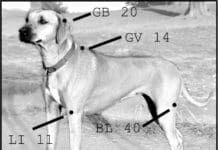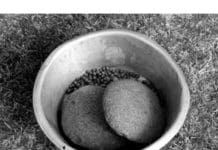Do Dog Supplements Really Work?
When a specific dietary supplement is given to an individual (canine or human) who previously lacked the nutrients or chemicals offered by the supplement, or whose body required a higher dose than was previously available, miraculous improvements in health, appearance, and attitude can indeed take place. But most people have no idea whether they are lacking something before they add it to their own or their dog’s diet!
Deworming Products and Parasite Control for Dogs
Manufacturers of deworming products have gone out of their way to let us know that, left unchecked, these pesky parasites can plague dogs that are in poor health, rob them of nutrition, attack vital organs, and cause unthriftyness, illness, and even death. If a dog's health is poor and he is hosting an uncontested parasite population, all sorts of bad things can happen. It is important to protect our dogs from parasites, but as it turns out, protection largely follows as a result of building the dog's overall health. Toxic dewormers may be unnecessary to dislodge what few worms a strong and healthy animal might have.
Recovery From a ‘Fetch’ Injury
You’ve played this game thousands of times. You’ve got a few minutes, and your maniacally loyal canine companion is eager to play fetch, begging for it, ball in mouth, dropping it at your feet, barking in joyful anticipation. Then it happened. Willie slipped, tried to stop, and twisted into a ball with a yelp. He lay paralyzed from the middle of the back down, lying quietly on the frozen ground as Rogers rushed over.
Colitis: An Urgent Problem
Conventional medical practitioners use the word colitis to indicate inflammation of the colon (the large intestine), as opposed to inflammation of the small intestine or the stomach. One of the large intestine’s most important roles is to absorb water. If the colon is not functioning properly, a lot of water is left in the stool; that’s diarrhea. There are many different types of diarrhea, and, unpleasant as it may be to contemplate, the characteristics of the diarrhea help us identify which part of the dog’s digestive system is not working properly.
Reduced Vaccination Schedule
An annual booster using distemper, hepatitis, parainfluenza, killed or modified-live virus parvovirus is given at one year of age. Thereafter, boosters are given every three years until old age. Beyond 10 years of age, booster vaccinations are generally not needed, and may be unwise if aging or other diseases are present. For animals at high exposure risk to parvovirus disease, an additional parvovirus vaccination can be given at the six-month point, if killed parvovirus is used. This extra booster is typically not needed if MLV parvovirus is used.
Preventing Hot Spots
Upon waking up one morning many years ago, I greeted Mandy, my six-year-old tri-color Collie, who slept beside my bed. As I leaned over to stroke her luxurious black coat, I gasped. There was an angry, oozing sore the size of a grapefruit on the outside of her right hind leg. It was cherry red, inflamed, and looked incredibly painful. I was horrified. I worked at a humane society at the time. This looked like the kind of wound we would investigate an irresponsible owner for, for not providing proper care and attention! I was sure it hadn't been there the night before. What had happened to my dog?
Change of Dog Food Stops Seizures
On April Fool's Day 1996, my soon-to-be-husband took me to get a puppy. We already had one dog, Ladybird, but she was getting older and we felt a young friend would encourage her to be more playful. We also hoped Ladybird would pass on some of her fine qualities to the puppy. We drove out of town to a place where people play paintball. There were more than a dozen young dogs running around, and the owner told us to take our pick. One young female seemed to want my attention more than any of the others, and I fell in love with her pretty face. We took her home and named her Cheyenne.
Urine Trouble
My 2-1/2 year old spayed female Akita is showing a pattern of recurring bladder infections. An ultrasound showed scar tissue from a long-term infection before I adopted her from a rescue group. When she gets an infection, there is blood in her urine and the pH is 9.0. I understand there is a chicken and egg argument about the high pH and infections. Is there anything that will help lower the pH of her urine and make her less prone to infection, or is the high pH more likely just a result of the infection?
Case of the Missing Hormones
Incontinence in spayed females is fairly common. The problem is caused by a lack of estrogen, which, of course, was brought about by the spay surgery. Many people assume that when females are spayed, the veterinarian simply “ties the tubes,” that is, cuts and ties off the fallopian tubes so that the ovum can not travel from the ovaries, down the fallopian tubes, and become fertilized. Actually, the veterinarian removes the ovaries and usually, the uterus, too. The reason for this is that you not only want the female to become incapable of becoming pregnant, but also, you want her not to exhibit symptoms of heat.
Identifying and Treating Bloat in Dogs Before It’s Too Late
Gastric dilatation-volvulus, or bloat" for short
Neutering Saves Lives by Reducing Cancer Risks
Most people respond with a warm fuzzy Awwww" reaction when they see a litter of puppies. After all
Lick Granulomas
A lick granuloma is a red, raw, and ugly looking wound, caused by a dog's incessant licking. The last thing one would think is that it can be a blessing in disguise, but it seems to have been just that for Biggie, a 10-year-old Weimaraner owned by Maryland breeders Bob and Virginia (Gini) Selner. Biggie (AKA Wyngate's Music Man") is one of five dogs who live with the Selners


















